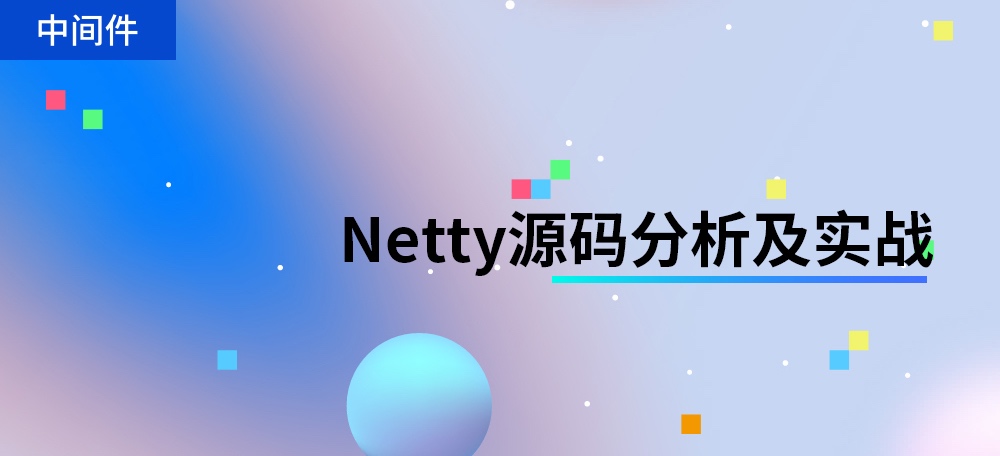Netty源码分析之pipeline(一)原创
通过前面的源码系列文章中的netty reactor线程三部曲,我们已经知道,netty的reactor线程就像是一个发动机,驱动着整个netty框架的运行,而服务端的绑定和新连接的建立正是发动机的导火线,将发动机点燃
netty在服务端端口绑定和新连接建立的过程中会建立相应的channel,而与channel的动作密切相关的是pipeline这个概念,pipeline像是可以看作是一条流水线,原始的原料(字节流)进来,经过加工,最后输出
本文,我将以新连接的建立为例分为以下几个部分给你介绍netty中的pipeline是怎么玩转起来的
- pipeline 初始化
- pipeline 添加节点
- pipeline 删除节点
pipeline 初始化
在新连接的建立这篇文章中,我们已经知道了创建NioSocketChannel的时候会将netty的核心组件创建出来

pipeline是其中的一员,在下面这段代码中被创建
AbstractChannel
protected AbstractChannel(Channel parent) {
this.parent = parent;
id = newId();
unsafe = newUnsafe();
pipeline = newChannelPipeline();
}
AbstractChannel
protected DefaultChannelPipeline newChannelPipeline() {
return new DefaultChannelPipeline(this);
}
DefaultChannelPipeline
protected DefaultChannelPipeline(Channel channel) {
this.channel = ObjectUtil.checkNotNull(channel, "channel");
tail = new TailContext(this);
head = new HeadContext(this);
head.next = tail;
tail.prev = head;
}
pipeline中保存了channel的引用,创建完pipeline之后,整个pipeline是这个样子的
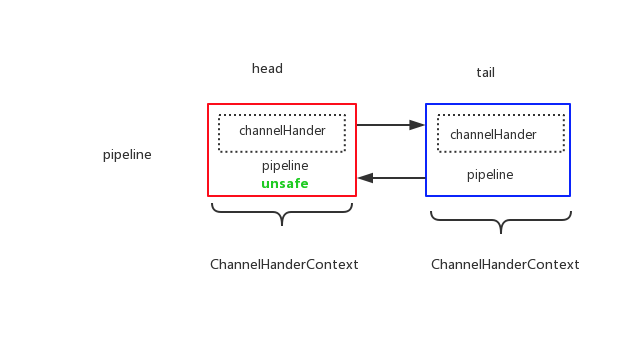
pipeline中的每个节点是一个ChannelHandlerContext对象,每个context节点保存了它包裹的执行器 ChannelHandler 执行操作所需要的上下文,其实就是pipeline,因为pipeline包含了channel的引用,可以拿到所有的context信息
默认情况下,一条pipeline会有两个节点,head和tail,后面的文章我们具体分析这两个特殊的节点,今天我们重点放在pipeline
pipeline添加节点
下面是一段非常常见的客户端代码
bootstrap.childHandler(new ChannelInitializer<SocketChannel>() {
@Override
public void initChannel(SocketChannel ch) throws Exception {
ChannelPipeline p = ch.pipeline();
p.addLast(new Spliter())
p.addLast(new Decoder());
p.addLast(new BusinessHandler())
p.addLast(new Encoder());
}
});
首先,用一个spliter将来源TCP数据包拆包,然后将拆出来的包进行decoder,传入业务处理器BusinessHandler,业务处理完encoder,输出
整个pipeline结构如下

我用两种颜色区分了一下pipeline中两种不同类型的节点,一个是 ChannelInboundHandler,处理inBound事件,最典型的就是读取数据流,加工处理;还有一种类型的Handler是 ChannelOutboundHandler, 处理outBound事件,比如当调用writeAndFlush()类方法时,就会经过该种类型的handler
不管是哪种类型的handler,其外层对象 ChannelHandlerContext 之间都是通过双向链表连接,而区分一个 ChannelHandlerContext到底是in还是out,在添加节点的时候我们就可以看到netty是怎么处理的
DefaultChannelPipeline
@Override
public final ChannelPipeline addLast(ChannelHandler... handlers) {
return addLast(null, handlers);
}
@Override
public final ChannelPipeline addLast(EventExecutorGroup executor, ChannelHandler... handlers) {
for (ChannelHandler h: handlers) {
addLast(executor, null, h);
}
return this;
}
public final ChannelPipeline addLast(EventExecutorGroup group, String name, ChannelHandler handler) {
final AbstractChannelHandlerContext newCtx;
synchronized (this) {
// 1.检查是否有重复handler
checkMultiplicity(handler);
// 2.创建节点
newCtx = newContext(group, filterName(name, handler), handler);
// 3.添加节点
addLast0(newCtx);
}
// 4.回调用户方法
callHandlerAdded0(handler);
return this;
}
这里简单地用synchronized方法是为了防止多线程并发操作pipeline底层的双向链表
我们还是逐步分析上面这段代码
1.检查是否有重复handler
在用户代码添加一条handler的时候,首先会查看该handler有没有添加过
private static void checkMultiplicity(ChannelHandler handler) {
if (handler instanceof ChannelHandlerAdapter) {
ChannelHandlerAdapter h = (ChannelHandlerAdapter) handler;
if (!h.isSharable() && h.added) {
throw new ChannelPipelineException(
h.getClass().getName() +
" is not a @Sharable handler, so can't be added or removed multiple times.");
}
h.added = true;
}
}
netty使用一个成员变量added标识一个channel是否已经添加,上面这段代码很简单,如果当前要添加的Handler是非共享的,并且已经添加过,那就抛出异常,否则,标识该handler已经添加
由此可见,一个Handler如果是sharable的,就可以无限次被添加到pipeline中,我们客户端代码如果要让一个Handler被共用,只需要加一个@Sharable标注即可,如下
@Sharable
public class BusinessHandler {
}
而如果Handler是sharable的,一般就通过spring的注入的方式使用,不需要每次都new 一个
isSharable() 方法正是通过该Handler对应的类是否标注@Sharable来实现的
ChannelHandlerAdapter
public boolean isSharable() {
Class<?> clazz = getClass();
Map<Class<?>, Boolean> cache = InternalThreadLocalMap.get().handlerSharableCache();
Boolean sharable = cache.get(clazz);
if (sharable == null) {
sharable = clazz.isAnnotationPresent(Sharable.class);
cache.put(clazz, sharable);
}
return sharable;
}
这里也可以看到,netty为了性能优化到极致,还使用了ThreadLocal来缓存Handler的状态,高并发海量连接下,每次有新连接添加Handler都会创建调用此方法
2.创建节点
回到主流程,看创建上下文这段代码
newCtx = newContext(group, filterName(name, handler), handler);
这里我们需要先分析 filterName(name, handler) 这段代码,这个函数用于给handler创建一个唯一性的名字
private String filterName(String name, ChannelHandler handler) {
if (name == null) {
return generateName(handler);
}
checkDuplicateName(name);
return name;
}
显然,我们传入的name为null,netty就给我们生成一个默认的name,否则,检查是否有重名,检查通过的话就返回
netty创建默认name的规则为 简单类名#0,下面我们来看些具体是怎么实现的
private static final FastThreadLocal<Map<Class<?>, String>> nameCaches =
new FastThreadLocal<Map<Class<?>, String>>() {
@Override
protected Map<Class<?>, String> initialValue() throws Exception {
return new WeakHashMap<Class<?>, String>();
}
};
private String generateName(ChannelHandler handler) {
// 先查看缓存中是否有生成过默认name
Map<Class<?>, String> cache = nameCaches.get();
Class<?> handlerType = handler.getClass();
String name = cache.get(handlerType);
// 没有生成过,就生成一个默认name,加入缓存
if (name == null) {
name = generateName0(handlerType);
cache.put(handlerType, name);
}
// 生成完了,还要看默认name有没有冲突
if (context0(name) != null) {
String baseName = name.substring(0, name.length() - 1);
for (int i = 1;; i ++) {
String newName = baseName + i;
if (context0(newName) == null) {
name = newName;
break;
}
}
}
return name;
}
netty使用一个 FastThreadLocal(后面的文章会细说)变量来缓存Handler的类和默认名称的映射关系,在生成name的时候,首先查看缓存中有没有生成过默认name(简单类名#0),如果没有生成,就调用generateName0()生成默认name,然后加入缓存
接下来还需要检查name是否和已有的name有冲突,调用context0(),查找pipeline里面有没有对应的context
private AbstractChannelHandlerContext context0(String name) {
AbstractChannelHandlerContext context = head.next;
while (context != tail) {
if (context.name().equals(name)) {
return context;
}
context = context.next;
}
return null;
}
context0()方法链表遍历每一个 ChannelHandlerContext,只要发现某个context的名字与待添加的name相同,就返回该context,最后抛出异常,可以看到,这个其实是一个线性搜索的过程
如果context0(name) != null 成立,说明现有的context里面已经有了一个默认name,那么就从 简单类名#1 往上一直找,直到找到一个唯一的name,比如简单类名#3
如果用户代码在添加Handler的时候指定了一个name,那么要做到事仅仅为检查一下是否有重复
private void checkDuplicateName(String name) {
if (context0(name) != null) {
throw new IllegalArgumentException("Duplicate handler name: " + name);
}
}
处理完name之后,就进入到创建context的过程,由前面的调用链得知,group为null,因此childExecutor(group)也返回null
DefaultChannelPipeline
private AbstractChannelHandlerContext newContext(EventExecutorGroup group, String name, ChannelHandler handler) {
return new DefaultChannelHandlerContext(this, childExecutor(group), name, handler);
}
private EventExecutor childExecutor(EventExecutorGroup group) {
if (group == null) {
return null;
}
//..
}
DefaultChannelHandlerContext
DefaultChannelHandlerContext(
DefaultChannelPipeline pipeline, EventExecutor executor, String name, ChannelHandler handler) {
super(pipeline, executor, name, isInbound(handler), isOutbound(handler));
if (handler == null) {
throw new NullPointerException("handler");
}
this.handler = handler;
}
构造函数中,DefaultChannelHandlerContext将参数回传到父类,保存Handler的引用,进入到其父类
AbstractChannelHandlerContext
AbstractChannelHandlerContext(DefaultChannelPipeline pipeline, EventExecutor executor, String name,
boolean inbound, boolean outbound) {
this.name = ObjectUtil.checkNotNull(name, "name");
this.pipeline = pipeline;
this.executor = executor;
this.inbound = inbound;
this.outbound = outbound;
}
netty中用两个字段来表示这个channelHandlerContext属于inBound还是outBound,或者两者都是,两个boolean是通过下面两个小函数来判断(见上面一段代码)
DefaultChannelHandlerContext
private static boolean isInbound(ChannelHandler handler) {
return handler instanceof ChannelInboundHandler;
}
private static boolean isOutbound(ChannelHandler handler) {
return handler instanceof ChannelOutboundHandler;
}
通过instanceof关键字根据接口类型来判断,因此,如果一个Handler实现了两类接口,那么他既是一个inBound类型的Handler,又是一个outBound类型的Handler,比如下面这个类
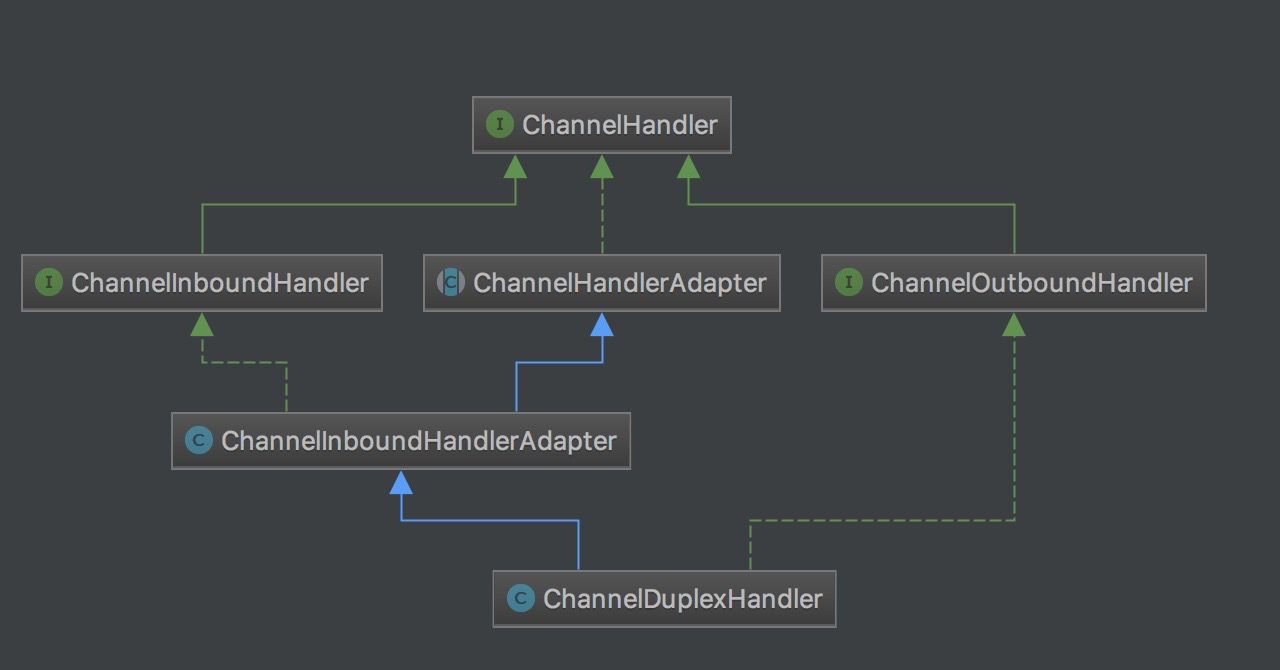
常用的,将decode操作和encode操作合并到一起的codec,一般会继承 MessageToMessageCodec,而MessageToMessageCodec就是继承ChannelDuplexHandler
MessageToMessageCodec
public abstract class MessageToMessageCodec<INBOUND_IN, OUTBOUND_IN> extends ChannelDuplexHandler {
protected abstract void encode(ChannelHandlerContext ctx, OUTBOUND_IN msg, List<Object> out)
throws Exception;
protected abstract void decode(ChannelHandlerContext ctx, INBOUND_IN msg, List<Object> out)
throws Exception;
}
context 创建完了之后,接下来终于要将创建完毕的context加入到pipeline中去了
3.添加节点
private void addLast0(AbstractChannelHandlerContext newCtx) {
AbstractChannelHandlerContext prev = tail.prev;
newCtx.prev = prev; // 1
newCtx.next = tail; // 2
prev.next = newCtx; // 3
tail.prev = newCtx; // 4
}
用下面这幅图可见简单的表示这段过程,说白了,其实就是一个双向链表的插入操作
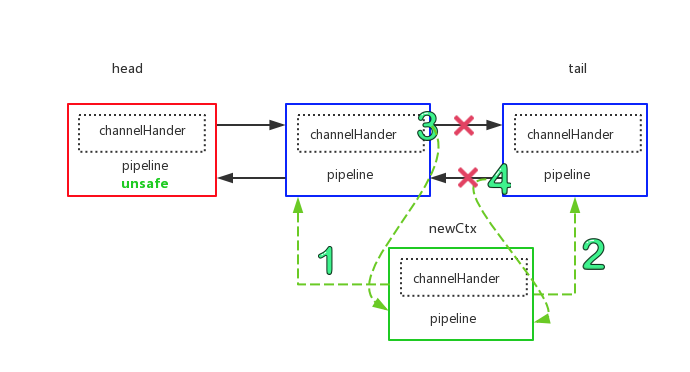
操作完毕,该context就加入到pipeline中

到这里,pipeline添加节点的操作就完成了,你可以根据此思路掌握所有的addxxx()系列方法
4.回调用户方法
AbstractChannelHandlerContext
private void callHandlerAdded0(final AbstractChannelHandlerContext ctx) {
ctx.handler().handlerAdded(ctx);
ctx.setAddComplete();
}
到了第四步,pipeline中的新节点添加完成,于是便开始回调用户代码 ctx.handler().handlerAdded(ctx);,常见的用户代码如下
AbstractChannelHandlerContext
public class DemoHandler extends SimpleChannelInboundHandler<...> {
@Override
public void handlerAdded(ChannelHandlerContext ctx) throws Exception {
// 节点被添加完毕之后回调到此
// do something
}
}
接下来,设置该节点的状态
AbstractChannelHandlerContext
final void setAddComplete() {
for (;;) {
int oldState = handlerState;
if (oldState == REMOVE_COMPLETE || HANDLER_STATE_UPDATER.compareAndSet(this, oldState, ADD_COMPLETE)) {
return;
}
}
}
用cas修改节点的状态至:REMOVE_COMPLETE(说明该节点已经被移除) 或者 ADD_COMPLETE
pipeline删除节点
netty 有个最大的特性之一就是Handler可插拔,做到动态编织pipeline,比如在首次建立连接的时候,需要通过进行权限认证,在认证通过之后,就可以将此context移除,下次pipeline在传播事件的时候就就不会调用到权限认证处理器
下面是权限认证Handler最简单的实现,第一个数据包传来的是认证信息,如果校验通过,就删除此Handler,否则,直接关闭连接
public class AuthHandler extends SimpleChannelInboundHandler<ByteBuf> {
@Override
protected void channelRead0(ChannelHandlerContext ctx, ByteBuf data) throws Exception {
if (verify(authDataPacket)) {
ctx.pipeline().remove(this);
} else {
ctx.close();
}
}
private boolean verify(ByteBuf byteBuf) {
//...
}
}
重点就在 ctx.pipeline().remove(this) 这段代码
@Override
public final ChannelPipeline remove(ChannelHandler handler) {
remove(getContextOrDie(handler));
return this;
}
remove操作相比add简单不少,分为三个步骤:
1.找到待删除的节点
2.调整双向链表指针删除
3.回调用户函数
1.找到待删除的节点
DefaultChannelPipeline
private AbstractChannelHandlerContext getContextOrDie(ChannelHandler handler) {
AbstractChannelHandlerContext ctx = (AbstractChannelHandlerContext) context(handler);
if (ctx == null) {
throw new NoSuchElementException(handler.getClass().getName());
} else {
return ctx;
}
}
@Override
public final ChannelHandlerContext context(ChannelHandler handler) {
if (handler == null) {
throw new NullPointerException("handler");
}
AbstractChannelHandlerContext ctx = head.next;
for (;;) {
if (ctx == null) {
return null;
}
if (ctx.handler() == handler) {
return ctx;
}
ctx = ctx.next;
}
}
这里为了找到Handler对应的context,照样是通过依次遍历双向链表的方式,直到某一个context的Handler和当前Handler相同,便找到了该节点
2.调整双向链表指针删除
DefaultChannelPipeline
private AbstractChannelHandlerContext remove(final AbstractChannelHandlerContext ctx) {
assert ctx != head && ctx != tail;
synchronized (this) {
// 2.调整双向链表指针删除
remove0(ctx);
}
// 3.回调用户函数
callHandlerRemoved0(ctx);
return ctx;
}
private static void remove0(AbstractChannelHandlerContext ctx) {
AbstractChannelHandlerContext prev = ctx.prev;
AbstractChannelHandlerContext next = ctx.next;
prev.next = next; // 1
next.prev = prev; // 2
}
经历的过程要比添加节点要简单,可以用下面一幅图来表示
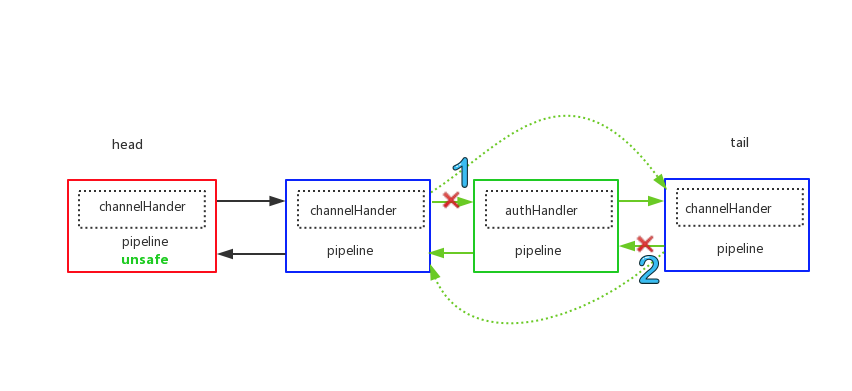
最后的结果为
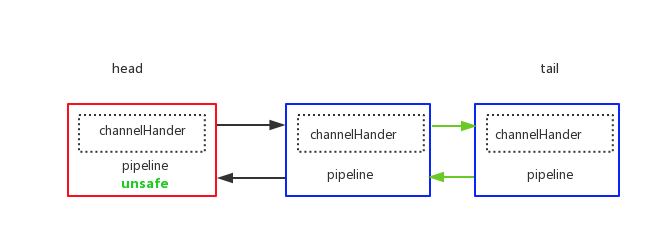
结合这两幅图,可以很清晰地了解权限验证Handler的工作原理,另外,被删除的节点因为没有对象引用到,果过段时间就会被gc自动回收
3.回调用户函数
private void callHandlerRemoved0(final AbstractChannelHandlerContext ctx) {
try {
ctx.handler().handlerRemoved(ctx);
} finally {
ctx.setRemoved();
}
}
到了第三步,pipeline中的节点删除完成,于是便开始回调用户代码 ctx.handler().handlerRemoved(ctx);,常见的代码如下
AbstractChannelHandlerContext
public class DemoHandler extends SimpleChannelInboundHandler<...> {
@Override
public void handlerRemoved(ChannelHandlerContext ctx) throws Exception {
// 节点被删除完毕之后回调到此,可做一些资源清理
// do something
}
}
最后,将该节点的状态设置为removed
final void setRemoved() {
handlerState = REMOVE_COMPLETE;
}
removexxx系列的其他方法族大同小异,你可以根据上面的思路展开其他的系列方法,这里不再赘述
总结
1.以新连接创建为例,新连接创建的过程中创建channel,而在创建channel的过程中创建了该channel对应的pipeline,创建完pipeline之后,自动给该pipeline添加了两个节点,即ChannelHandlerContext,ChannelHandlerContext中有用pipeline和channel所有的上下文信息。
2.pipeline是双向个链表结构,添加和删除节点均只需要调整链表结构
3.pipeline中的每个节点包着具体的处理器ChannelHandler,节点根据ChannelHandler的类型是ChannelInboundHandler还是ChannelOutboundHandler来判断该节点属于in还是out或者两者都是
下一篇文章将继续pipeline的分析,敬请期待!
如果你觉得看的不过瘾,想系统学习Netty原理,那么你一定不要错过我的Netty源码分析系列视频:https://coding.imooc.com/class/230.html

